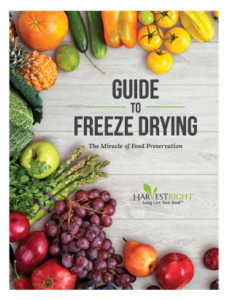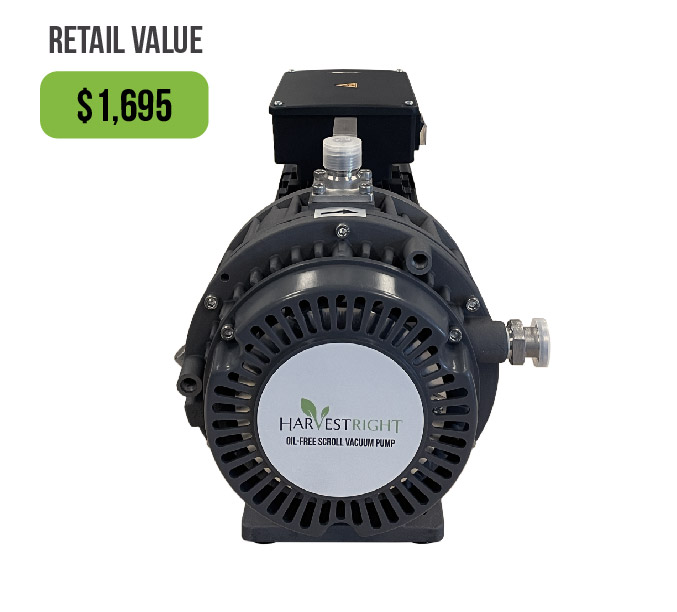Batch Preparation Guide
Freeze drying lets you preserve a wide variety of foods and even some non-food items. The first step to a successful batch is knowing what you can and cannot freeze dry.
What Cannot Be Freeze Dried
Some products do not freeze dry well due to their high fat or sugar content. Freeze drying only removes water—oils and fats will remain, which can affect quality and shelf life.
Do not freeze dry:
Chocolate
- Pure chocolate is already low in water and high in fat (18–20% cocoa butter).
- It will melt and burn during freeze drying, making cleanup difficult.
- Tip: Chocolate in baked goods can be freeze dried successfully.
Butter
- Butter is about 80% fat and will melt and burn in the freeze dryer.
- Tip: Butter in baked goods can be freeze dried.
Nuts, Seeds, & Nut Butters
- These are 50–75% fat and do not change much during freeze drying.
- Even when mixed into other products, they do not freeze dry well.
Honey, Syrup, & Fruit Preserves
- These are sugar-based and hold onto water tightly.
- Freeze drying cannot remove all the water, so some will always remain.
Batch Types & Loading Recommendations
- Avoid mixing different foods in the same batch or tray to prevent flavor and odor transfer.
- Do not mix pre-frozen and non-frozen items in the same batch—this can lower quality and increase batch time.
- Liquids can be poured directly onto trays or into silicone molds.
Low Moisture Batches
These process quickly due to low starting moisture.
Candy
- Needs higher shelf temperatures (150°F+).
- Batches finish in about 5–8 hours.
- The goal is usually a textural change, not complete moisture removal.
Cannabis
- Sensitive to high temperatures—use lower shelf temps (0–50°F).
- Batches run about 24 hours due to lower drying temperatures.
Standard Moisture Batches
Most foods fall into this category. Batches take 24–36 hours.
Preparation tips:
- Cut food so pieces are no thicker than the tray height.
- Place food in a single layer on each tray.
- More product = longer batch time; less product = shorter batch time.
Fruits & Berries
- Can be freeze dried fresh or pre-frozen.
- Pierce or cut fruits with skins (like grapes or blueberries) to help moisture escape.
- Place cut fruits cut-side up.
Vegetables & Beans
- Can be fresh, canned, or pre-frozen.
- Rinse and optionally cook or blanch (root vegetables must be cooked or blanched).
- Corn, beans, and peas can be slightly layered; other veggies should be in a single layer.
Meat, Poultry, & Fish
- Can be freeze dried raw or cooked, fresh or pre-frozen.
- Remove as much fat as possible for best results and longer shelf life.
- Label all freeze dried meats clearly—freeze drying does not kill pathogens.
High Moisture Batches
These take 36–40+ hours and benefit from pre-freezing for at least 24 hours.
Milk
- Any type of milk can be freeze dried.
- Fill trays no more than 3/4 full and pre-freeze for at least 24 hours.
Eggs
- Can be freeze dried raw or cooked.
- Pre-freeze for at least 24 hours.
- Handle raw eggs with the same care as raw meat.
Soups & Stews
- Can be canned or fresh.
- Fill trays no more than halfway and pre-freeze for at least 24 hours.
Packaging Your Freeze Dried Food
- Release the vacuum by opening the drain valve.
- Open the door and remove the trays.
- Test for dryness before packaging. Break large pieces in half to check the center.
- If not fully dry, return trays to the chamber and add more dry time.
- Package food immediately after removing from the freeze dryer.
Storage Options
Mylar Bags (Recommended for Long-Term Storage)
- Add a 700cc oxygen absorber to each bag.
- Seal with the included impulse sealer.
#10 Cans (Long-Term Storage)
- Requires a can sealer.
- Great for bulk storage.
Canning Jars (Mid to Long-Term Storage)
- Store in a cool, dry, dark place to protect food quality.
Resealable Jars/Bags (Short-Term Storage)
- Use air-tight containers, with or without an oxygen absorber.
- Freeze dried food exposed to air will absorb moisture and spoil.
Tip: Always make sure your food is completely dry before storing. If you have questions or need more tips, check your Owner’s Manual or contact Harvest Right Customer Support.



